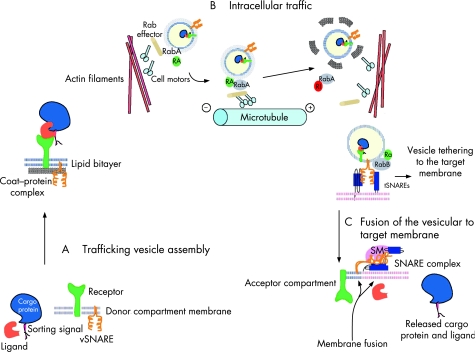Figure 1 Vesicular transport. (A) Trafficking vesicle assembly. Cargo protein displaying sorting signal forms a complex with its specific soluble ligand in the donor compartment. The ligand is recognised by the transmembrane receptor. Vesicular soluble N‐ethylmaleimide‐sensitive fusion attachment protein receptor protein (v‐SNARE) is present in the membrane of the donor compartment. Budding of the vesicle occurs with the aid of coat‐protein complexes and Rab proteins, which became active, acquiring GTP with the aid of Rab activator molecules (RA). (B) Intracellular traffic. Vesicles move along the cytoskeletal tracks, either actin filaments or microtubules, with the help of motor proteins, activated Rabs and Rab effector molecules. After Rab inactivation (RI) and dissociation of the protein coat, the vesicle becomes tethered to the acceptor compartment membrane and target SNARE (t‐SNARE) proteins. Tethering is achieved by a combination of tethering factors such as RabB and Sec1/Munc18 (SM) proteins. (C) Fusion of the vesicle to the target membrane. During fusion v‐SNARE and t‐SNARE proteins oppose and change conformation, forming a four‐helix bundle. The cargo protein and its ligand are released into the acceptor compartment for further sorting (adapted from Olkkonen and Ikonen15).

An official website of the United States government
Here's how you know
Official websites use .gov
A
.gov website belongs to an official
government organization in the United States.
Secure .gov websites use HTTPS
A lock (
) or https:// means you've safely
connected to the .gov website. Share sensitive
information only on official, secure websites.
